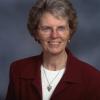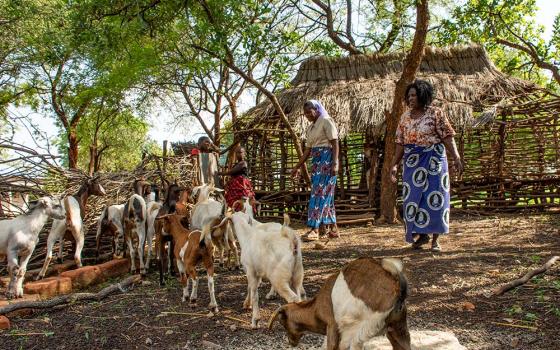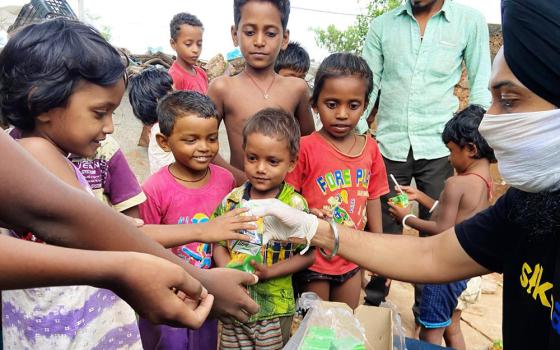Pope Francis kisses a gift presented to him by Sr. Jane Wakahiu during an audience with the board of directors of the Conrad Hilton Foundation at the Vatican on Jan. 22, 2025. Standing to the right is Sr. Joyce Meyer, a member of the Presentation of the Blessed Virgin Mary and a member of the foundation's board of directors. (CNS/Vatican Media)
Words take on flesh during site visits. This was my experience for five days as a board member for the Conrad N. Hilton Foundation when I visited the Union of International Superiors General in Rome and several Vatican departments, called dicasteries.
As board members, we read the names of project leaders — even had them join us as panel guests at times — and descriptions of their projects that provide information for us to make funding decisions. There is no doubt that as we read and deliberate, each of us creates images in our minds about the persons and projects described. But, meeting with the persons in the flesh, talking with them and witnessing their work brought our decision-making to life. We experienced flesh and blood at work in real places. Meetings like these generate energy for the best future decisions. (Conrad N. Hilton Foundation is a major funder of Global Sisters Report.)
The Catholic Sisters Initiative of the foundation had done amazing work to arrange meetings at Vatican offices where we fund projects. These offices are not all located in one place but scattered throughout the area. Each day, we boarded vans and traveled to different parts of Vatican City. The city became a sovereign nation in 1929 and is ruled by Pope Francis. Francis appointed Sr. Raffaella Petrini to the number one position in its government, replacing a cardinal and making her the highest-ranking woman in the world's smallest state. Because Vatican City is small, we traveled in and out of it into Rome for our meetings. We joked about needing our passports.
We began our five-day pilgrimage at the UISG offices, where we encountered the greatest number of sisters. UISG is a worldwide network of women leaders of religious congregations representing over 600,000 sisters. It was exciting for me to meet the leaders of the organization's programs: International Migrants and Refugee Network, Sister Formators Program, Communication for Religious Life, Safeguarding, Sisters Advocating Globally, Sowing Hope for the Planet and Talitha Kum. Each of these is an educational program to train sister leaders for initiatives that promote human dignity, social justice and integral human development. We learned from each leader how she and her team support and interact with women religious committed to these issues worldwide.
It was our privilege to participate in launching The Anna Trust: Catholic Sisters' Elder Care Fund and its global website. Susan Raymond, executive director, explained her new role and the goals to assist congregations in providing care for their sisters worldwide.
We also learned about the program of safeguarding and protecting children and vulnerable adults from Jesuit Fr. Hans Zollner, its director, and Sr. Patricia Murray, executive secretary of UISG. Many sisters have gained information and skills about safeguarding for their work with vulnerable populations, and now, the Institute of Anthropology at Gregorian University has begun a program to train sisters to become trainers of others to assist their communities and institutions in the principles and skills for safeguarding.
Even though the issue of abuse of vulnerable persons has been highlighted in the United States, it is still in the dark of denial for many other countries. We learned that only one bishop in Italy has ever made the issue public, and that is recent. Our world has a long way to go in protecting our children and vulnerable others.
The second visit that day was also amazing, a place I never dreamed I would find myself, the Secretariat for the Economy, the governing body of the Catholic Church. We primarily learned how complex the work of the secretariat is as it strives to bring outdated systems into the current economic systems needed today. Perhaps the most important thing I learned was how it is striving for more transparency as lay persons are in its management to make it a sustainable system.
That evening, Matteo Bruni, the director of the Holy See Press Office, educated us on the history of the Vatican State as both a spiritual and political organization. Bruni loves history, so he told us many interesting details about the church's political connections with the Roman Empire and the empire's continuing influence. There was too much information to share here, but a few things that struck me. One was the influence of Emperor Constantine, who, in legalizing Christianity, giving it financial support and even influencing doctrinal articulation, helped spread it as a religion as he went about colonizing Europe.
Pope Francis shakes hands with Linda Hilton, chair of the board of directors of the Conrad Hilton Foundation, during an audience with the foundation at the Vatican on Jan. 22, 2025. Standing with her is Salesian Sr. Alessandra Smerilli, secretary of the Dicastery for Promoting Integral Human Development. (CNS/Vatican Media)
The day that followed this history was primarily an experience of the spiritual side of Christianity, even though it was clear how political trappings were also present in the protocol around the private audience with Pope Francis as head of state.
Here, we had a touch of the humanity of this global institution. At 7 a.m., Pope Francis, dressed in white, entered the room in a wheelchair and then was helped to be seated in a simple armchair. We were seated in short rows on each side and listened to his address from there. It was brief but encouraged us in our support of sisters whose lives are given to service and to follow our founder's desire to never forget those in need of care and compassion because that was the mission of Jesus. It was touching to hear his words so gently given, at times, with a touch of humor.
Each of us then, following specific protocol, greeted him personally: not with genuflection or kissing his ring, but with a simple handshake. We could ask for his blessing and even present things for blessing. A sweet moment for me was our board intern showing the pope a picture of an ultrasound of his baby, and asking for his blessing.
Even though I wish the pope would speak stronger and clearer regarding women's place in the church, I am mindful of how much resistance he experiences from so many church leaders. I decided it was more important that day to thank him for what he has done to make the church aware of its mission to the margins.
The pope, though frail, greeted each of us with a smile and his own warm handshake. There was an atmosphere of warmth, reverence and quietness during the entire visit that was very moving for me. Having our board experience this sacred moment together was touching. We then went to breakfast in his dining room while he went on to another audience. I am amazed at his resilience and stamina.
After a tour of St. Peter's Basilica and a visit to St. Peter's tomb, we celebrated a private Mass in the catacombs of St. Peter, celebrated by Cardinal Luis Antonio Tagle, whom I met once in the Philippines.
Later in the afternoon, we went to the Leo XII Palace at the Vatican to learn about the history of the Dicastery for Communication and its role in communicating Pope Francis' vision and teachings to the world. All the news is communicated in 52 languages, and translation is only one of the 19 services of this dicastery. It was amazing to see the room lit with monitors.
Advertisement
At this same meeting, we were told about the Pentecost Project by Paolo Ruffini, prefect of the Dicastery of Communication. The purpose of the project is to make the lives and ministry of women religious better known through the weekly publishing of stories submitted by sisters and the opportunity for sisters to participate in a three-month training at Vatican News and Vatican Radio to enhance their journalistic and communication skills. Two sisters from the first session have now been hired at the Vatican to train others and to work in other dicasteries.
We ended the spiritual day at the Vatican Museums and, of course, the Sistine Chapel. We all logged hundreds of steps that day.
On our fourth day, we attended a Dicastery for Communications convening, organized through the Pentecost Project. Here, we met sisters from around the world involved in communication for their congregations or dioceses. There were sister leaders on a panel representing integral human development, Talitha Kum, pastoral care of people with disabilities and local work with women in Africa who spoke about the importance of telling stories of the suffering and resilience of those served and serving on the margins.
Another panel spoke on the importance of collaborating with other organizations to tell the stories of what sisters are doing around the world. The day ended with dinner with representatives from the groups in Rome and the Vatican who partnered with the foundation.
Our last day began with a meeting of representatives from the World Union of Catholic Women's Organizations. Many sisters worldwide partner with lay women's Catholic groups, and one of Hilton's goals is to promote such collaboration. A special moment after hearing about the work of the group was seeing a clip from "In-Visibles" by Lia Beltrami, its producer and director.
The last event of our tour was also amazing, with the Dicastery for Promoting Integral Human Development on collective action for human dignity. It is through this dicastery that the foundation furthers the mission of the church by supporting sisters' education and strengthening strategic partnerships between sister and episcopal commissions and diocesan offices. Salesian Sr. Alessandra Smerilli, an economist, is the secretary for this dicastery. She also assists in training sisters who will be working in the Dicastery of Evangelization.
The days were full, but worth the energy to understand a bit about the church and who is the church. Meeting so many people of faith working hard to promote its true mission, the mission of Jesus, was inspiring. And it was so encouraging to see how Pope Francis has appointed more women and Catholic sisters to significant Vatican department positions. That gives us hope that this movement will continue to help bring about a church more deeply focused on its true mission.






